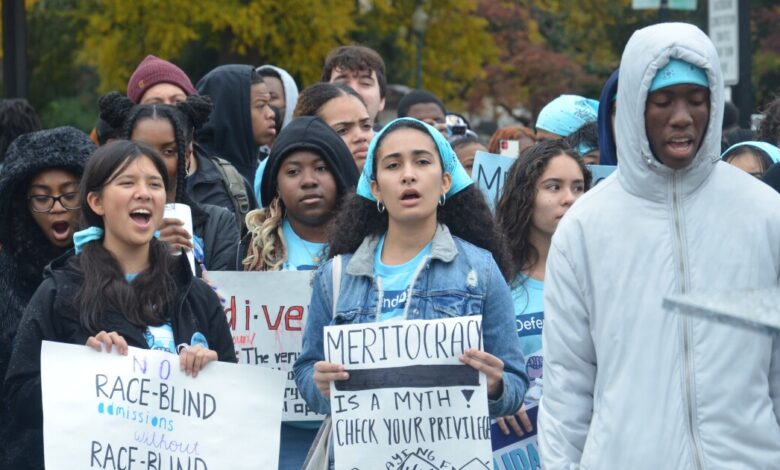It’s OK to Stop Calling It Affirmative Action

The U.S. Supreme Court is expected to release its long-awaited decision in two high-profile admissions cases by the end of the week. That big news will prompt many hundreds of headlines, most of which will surely include the term “affirmative action.”
But those headlines won’t be quite accurate. Technically and historically speaking, affirmative action isn’t the issue under review here.
The Supreme Court is poised to issue an opinion that will determine the fate of race-conscious admissions policies. Whether you support those policies or not, it’s important to use the right term when discussing a controversial practice that most everyone expects the justices to eradicate. Words matter, after all. And it’s never too late to understand what something is — and what it isn’t.
At a recent enrollment conference, Art Coleman, managing partner and co-founder of EducationCounsel LLC, described the potential implications of the court’s forthcoming decision in the two admissions-discrimination cases, which involve Harvard University and the University of North Carolina at Chapel Hill. Coleman, a former deputy assistant secretary of the U.S. Department of Education’s Office for Civil Rights, emphasized the importance of institutional leaders’ using the most precise terms possible when describing what’s at stake in those cases: “We are not talking about affirmative action — we just aren’t. Let’s get rid of a term that’s just wrong on every front.”
To understand what he means, let’s review a bit. Generally, “affirmative action” refers to policies and practices meant to promote opportunities for members of historically marginalized groups. (Anyone who’s really interested can go find the term in early 20th-century employment-law passages.) As clunky as those two words together might sound, they conveyed an important meaning: The need for the government to move proactively in creating more-equitable conditions for Americans — instead of just waiting for the status quo to magically change on its own.
The term entered the vernacular during the civil-rights era, after President John F. Kennedy in 1961 issued an Executive Order instructing federal contractors to take “affirmative action to ensure that applicants are treated equally without regard to race, color, religion, sex, or national origin.” Four years later, President Lyndon B. Johnson signed another Executive Order that prohibited discrimination by employers receiving federal contracts. President Johnson amended the order two years later to add sex to the list of anti-discrimination provisions. In short, Johnson’s EO put greater clarity and oomph behind the government’s push to promote equal opportunity for women and minorities in the work force.
Let’s get rid of a term that’s just wrong on every front.
Affirmative action was understood as the widespread attempt to promote greater equality. It was a controversial means of leveling the playing field in a society long defined by racial bias, an acknowledgment of centuries-old disadvantages that hindered many Americans in their pursuit of jobs — and higher education.
Then came a 1978 Supreme Court decision that reshaped a national debate and changed colleges’ thinking about race for good. In Regents of the University of California v. Bakke, Justice Lewis F. Powell Jr., who cast the deciding vote, carved out a delicate and surprising position: The use of racial quotas was unconstitutional discrimination, the court’s opinion said, but colleges could consider an applicant’s race as one of many factors in admissions. The only justification for doing so, the opinion stated, was to achieve the educational benefits of student diversity.
The court’s landmark decision shifted the legal foundation for the use of race in admissions. “Before Bakke,” The Chronicle wrote three decades later, “selective colleges regarded race-conscious admissions policies mainly as a way to remedy past societal discrimination against Black, Hispanic, and Native American applicants. The Bakke ruling declared that justification off limits, replacing a rationale grounded in history with one grounded in educational theory.”
That rationale was forward looking, says Liliana M. Garces, a professor of higher education at the University of Texas at Austin. “The Bakke case ended up leading to this shift in practice, with institutions engaging in race-conscious admissions and moving away from affirmative action as originally implemented and conceived — as taking steps to address the uneven playing field,” she said. “The court shifted the goal for why race could be used, but, most importantly, it shifted the means for considering it. This becomes a common-sense approach to admissions in which you’re looking at the whole student in a holistic way, considering their backgrounds and experiences, what they might bring to the table.”
Some people might liken the distinction between the terms “affirmative action” and “race-conscious admissions” to one person saying “to-may-to” and another saying “to-mah-to.” But there’s more to it. And if colleges are barred from considering an applicant’s race in admissions, it’s important to know exactly what will have been lost.
“This distinction really matters,” says Garces, who studies how legal and educational systems affect the educational opportunities of marginalized students. “It matters because ‘race-conscious admissions’ points to a process that ensures fair treatment for students who are white, as well as students of other races or ethnicities.” Garces says it’s not an approach that “automatically places a thumb on the scale for students of color, which is what affirmative action is associated with. When you remove the consideration of race as a factor in admissions, you create an unequal treatment for students of color, whose race and ethnicity, and how that has shaped their experience, would no longer be a factor that admissions officers can consider.”
What to call that outcome is up to you.
Source link






